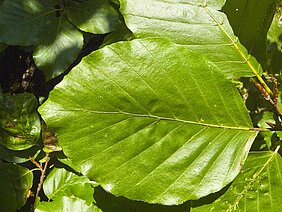The comparison of current TFA concentrations in precipitation with the values from the mid-1990s indicates an increase in the atmospheric input of TFA within the last decades in Germany. Due to the physicochemical properties of TFA, it can be assumed that, analogous to the increase in TFA levels in precipitation, TFA levels in plants have also increased. However, systematic studies regarding temporal trends for TFA in plants were not available before the start of the project. This knowledge gap has now been filled using archived plant samples from the German Environmental Specimen bank.
First, a powerful analytical method for the sample matrix was developed. Leaf or needle samples of the tree species European beech (Fagus sylvatica), black poplar (Populus nigra 'Italica'), Norway spruce (Picea abies) and Scots pine (Pinus sylvestris) from different sampling sites within Germany were investigated. The collected time series of TFA concentrations covers the period from 1989 to 2020.
The TFA concentrations of investigated leaf and needle samples were predominantly in the two- to three-digit µg/kg range (dry weight). Samples from different locations of the same tree species were each in a similar concentration range. The highest TFA levels were found in samples of black poplar. Here, concentrations of more than 1000 µg/kg dry weight were detected. A statistically significant positive trend in TFA concentration within the study period was found for three of the four sampled red beech sites and for both black poplar sites. The results of the needle samples also indicate an increase in TFA concentration during the study period, although no
statistical trend analysis was conducted for these matrices due to the small number of samples.
The results obtained in this study illustrate the ubiquitous occurrence of TFA in the environment and the positive trend of concentrations within the observation period represents a clear indication of an increasing atmospheric input of TFA into the (terrestrial) environment. This is particularly relevant in view of the projected increase in atmospheric input of TFA because of expected increasing emissions of gaseous precursors of the compound.
Publication:
Freeling, F.; Scheurer, M.; Koschorreck, J.; Hoffmann, G.; Ternes, T. Nödler, K.: Levels and Temporal Trends of Trifluoroacetate (TFA) in Archived Plants: Evidence for Increasing Emissions of Gaseous TFA Precursors over the Last Decades. Environmental Science & Technology Letters 9, 400 -405 (2022)
DOI: doi.org/10.1021/acs.estlett.2c00164

![[Translate to English:] Prüfstelle-Produktprüfung_Teststand Test centre and product testing](/fileadmin/_processed_/0/9/csm_TZW-Karlsruhe_Pruefung_Geraete-Teststand_377188946c.jpg)
























